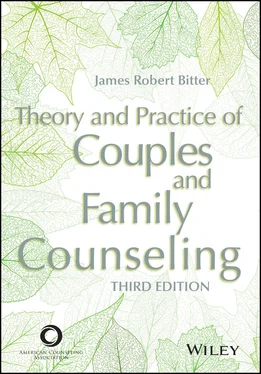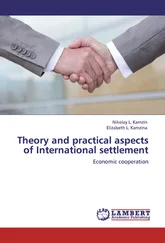James Robert Bitter - Theory and Practice of Couples and Family Counseling
Здесь есть возможность читать онлайн «James Robert Bitter - Theory and Practice of Couples and Family Counseling» — ознакомительный отрывок электронной книги совершенно бесплатно, а после прочтения отрывка купить полную версию. В некоторых случаях можно слушать аудио, скачать через торрент в формате fb2 и присутствует краткое содержание. Жанр: unrecognised, на английском языке. Описание произведения, (предисловие) а так же отзывы посетителей доступны на портале библиотеки ЛибКат.
- Название:Theory and Practice of Couples and Family Counseling
- Автор:
- Жанр:
- Год:неизвестен
- ISBN:нет данных
- Рейтинг книги:5 / 5. Голосов: 1
-
Избранное:Добавить в избранное
- Отзывы:
-
Ваша оценка:
- 100
- 1
- 2
- 3
- 4
- 5
Theory and Practice of Couples and Family Counseling: краткое содержание, описание и аннотация
Предлагаем к чтению аннотацию, описание, краткое содержание или предисловие (зависит от того, что написал сам автор книги «Theory and Practice of Couples and Family Counseling»). Если вы не нашли необходимую информацию о книге — напишите в комментариях, мы постараемся отыскать её.
Theory and Practice of Couples and Family Counseling — читать онлайн ознакомительный отрывок
Ниже представлен текст книги, разбитый по страницам. Система сохранения места последней прочитанной страницы, позволяет с удобством читать онлайн бесплатно книгу «Theory and Practice of Couples and Family Counseling», без необходимости каждый раз заново искать на чём Вы остановились. Поставьте закладку, и сможете в любой момент перейти на страницу, на которой закончили чтение.
Интервал:
Закладка:
Lynn formed a working relationship with Jay Haley at MRI that would last for years. The two of them became true scholar-practitioners, and both of them would eventually move to the East Coast of the United States. Haley worked with Minuchin for a while in Philadelphia before moving to Washington, DC, and establishing a family institute with Cloe Madanes.
Like Satir, Lynn completed a graduate degree in social work and eventually joined the Ackerman Institute in New York. There she worked with Peggy Papp and Olga Silverstein in what was called the Brief Therapy Project. Central to their work were strategic interventions based on paradoxes. In spite of its similarity to the structural-strategic model she had learned, this project required additional attention to language and metaphor. She worked there as part of a team, and though it remained strategic in nature for a long time, Lynn gradually moved in a different direction. Her work evolved into and adopted postmodern approaches to family counseling. In later years, when she reinterviewed families from her strategic period, a number of them would tell her that they simply chose to ignore the paradoxical directives that were given to them.
Lynn entered into postmodern thinking partly because of the influence of Harold Goolishian, who would cofound with Harlene Anderson what is often called linguistic therapy (Anderson & Goolishian, 1992). Lynn’s work in teams also incorporated the therapeutic dialogues associated with reflecting teams based on another neo-strategic model developed by Tom Andersen (1991). It is safe to say that no one has developed and grown more across the spectrum of family counseling than Lynn Hoffman, from her initial meetings with Satir, to her work with Haley, to the team processes at the Ackerman Institute, and finally to her current postmodern approach. In all of her transformations, she did not just perform family counseling, she wrote about it and developed its language, thoughts, and orientations.
Hoffman would later look back on her work with Virginia Satir and see the seeds of her eventual postmodern approach:
Most early family therapy has been aimed at locating a cause for the problem, but Satir went in a different direction from the start. She gave all her attention to leading families out of the shadow of blame, coming as close as anyone did in those days to inventing a no-fault type of practice. She also showed me what a therapy that created possibilities rather than correcting pathologies might be like. She was a skillful weaver who asked the family to join her in making handsome, useful textiles from the most unlikely threads. (Hoffman, 2002, p. 9)
Satir developed many unique interventions for working with families and groups, including sculpting, ropes, parts parties, family reconstruction, ingredients of an interaction, and the human mandala. The process of sculpting was more fully developed by Bunny Duhl, who with her former husband Fred Duhl had formed the Boston Family Therapy Institute: Both were early members of Satir’s AVANTA Network. Many of Satir’s interventions were initiated on the spur of the moment to help families with whom she worked; all of her interventions were experiential in nature.
Virginia Satir and Lynn Hoffman were two women who set out to learn, to understand, and to make a difference with the families they served. They were given few advantages in the field, but they took advantage of the opportunities that presented themselves. I was lucky to meet and work with Virginia. I feel I have come to know Lynn through her writings. As new practitioners start their careers, I cannot help but wonder what they will learn, how they will grow and develop, and what they might contribute to the ever-changing and dynamic field of family practice.
The History of Family Counseling II: From Structure to Strategy to Solutions
Starting in the late 1950s and the early 1960s, two conceptual centers emerged that would dominate family counseling and therapy for two decades. The first was the development of structural family therapy, led by the charismatic Argentine psychiatrist Salvador Minuchin. The other was the MRI model of strategic family therapy with its epistemology developed by Gregory Bateson and its practice by Don Jackson, Jules Riskin, Jay Haley, and John Weakland. Jay Haley would eventually leave MRI and head to the East Coast, where he would work with Salvador Minuchin before moving to Washington, DC, to establish the Family Therapy Institute of Washington, DC. Haley was the most prominent of many strategic therapists who were influenced by the hypnotherapy of Milton Erickson. Haley became the most prolific writer in the strategic model, and his work would influence the development of a strategic center in Milan, Italy, where a team headed by Mara Selvini Palazzoli would experiment with circular questioning and many different prescriptions.
Two therapists influenced by MRI training would eventually turn the strategic model on its head. Steve de Shazer and his spouse, Insoo Kim Berg, started the Brief Family Therapy Center in Milwaukee, Wisconsin. Together with colleagues, like Eve Lipchik, and their students, John Walter, Jane Peller, and Michele Weiner- Davis, they would cocreate solution-focused therapy. Later, Weiner-Davis would join with Bill O’Hanlon, slightly modifying the original model to create solution-oriented therapy.
Salvador Minuchin
As is true of many of the early pioneers, there is a charismatic quality to Salvador Minuchin that is enhanced by his preference for demonstrations of his approach with actual families. Born in Argentina to Russian Jewish immigrants, Minuchin became a medical doctor with the anticipation of working in pediatrics. He left Argentina for Israel when that state was established in 1948, volunteering as a medical doctor in the Israeli army. Following the war with the Arabs, he came to the United States, where he began training in psychoanalysis as well as child psychiatry with Nathan Ackerman. Minuchin would return to Israel in 1952, where he worked with displaced children for 2 years. “Minuchin’s interest in working with entire families can be traced to this point in his career” (Becvar & Becvar, 2013, p. 32).
Upon his return to the United States, Minuchin completed his training in psychoanalysis, and in 1960 he took a position at the Wiltwyck School for Boys in New York City. It was there that Minuchin and his associates, Braulio Montalvo, Bernard G. Guerney, Jr., Bernice L. Rosman, and Florence Schumer (S. Minuchin et al., 1967), began working with inner-city delinquent children, most of whom were Black or Puerto Rican and who came from low-income, often ghettoized families. It is in this work that Minuchin first introduced the concept of structure to family counseling and began to define the function of structure in family systems.
Minuchin noticed that in troubled families, parents were either overly involved (enmeshed) or detached (disengaged) or both. Both of these structures eroded the parents’ abilities to provide effective leadership in the family. Minuchin came to believe that families had subsystems, and each subsystem had tasks, processes, and interactions that were appropriate to that subsystem but that often got derailed when the boundaries between the subsystems became either diffuse or too rigid.
Based on his earlier work, Minuchin was asked to be the director of the Philadelphia Child Guidance Clinic in 1965. He brought a number of his associates with him, and in 1967, Jay Haley joined them. Focusing on changing dysfunctional structures, Minuchin (1974/2012) taught colleagues and students through demonstrations on how to join with families, adopting the families’ preferred mode of operation, before attempting to restructure the family by interrupting dysfunctional patterns. His model of joining, assessment, and enactment would become standard practice for family counselors in the 1970s.
Читать дальшеИнтервал:
Закладка:
Похожие книги на «Theory and Practice of Couples and Family Counseling»
Представляем Вашему вниманию похожие книги на «Theory and Practice of Couples and Family Counseling» списком для выбора. Мы отобрали схожую по названию и смыслу литературу в надежде предоставить читателям больше вариантов отыскать новые, интересные, ещё непрочитанные произведения.
Обсуждение, отзывы о книге «Theory and Practice of Couples and Family Counseling» и просто собственные мнения читателей. Оставьте ваши комментарии, напишите, что Вы думаете о произведении, его смысле или главных героях. Укажите что конкретно понравилось, а что нет, и почему Вы так считаете.












